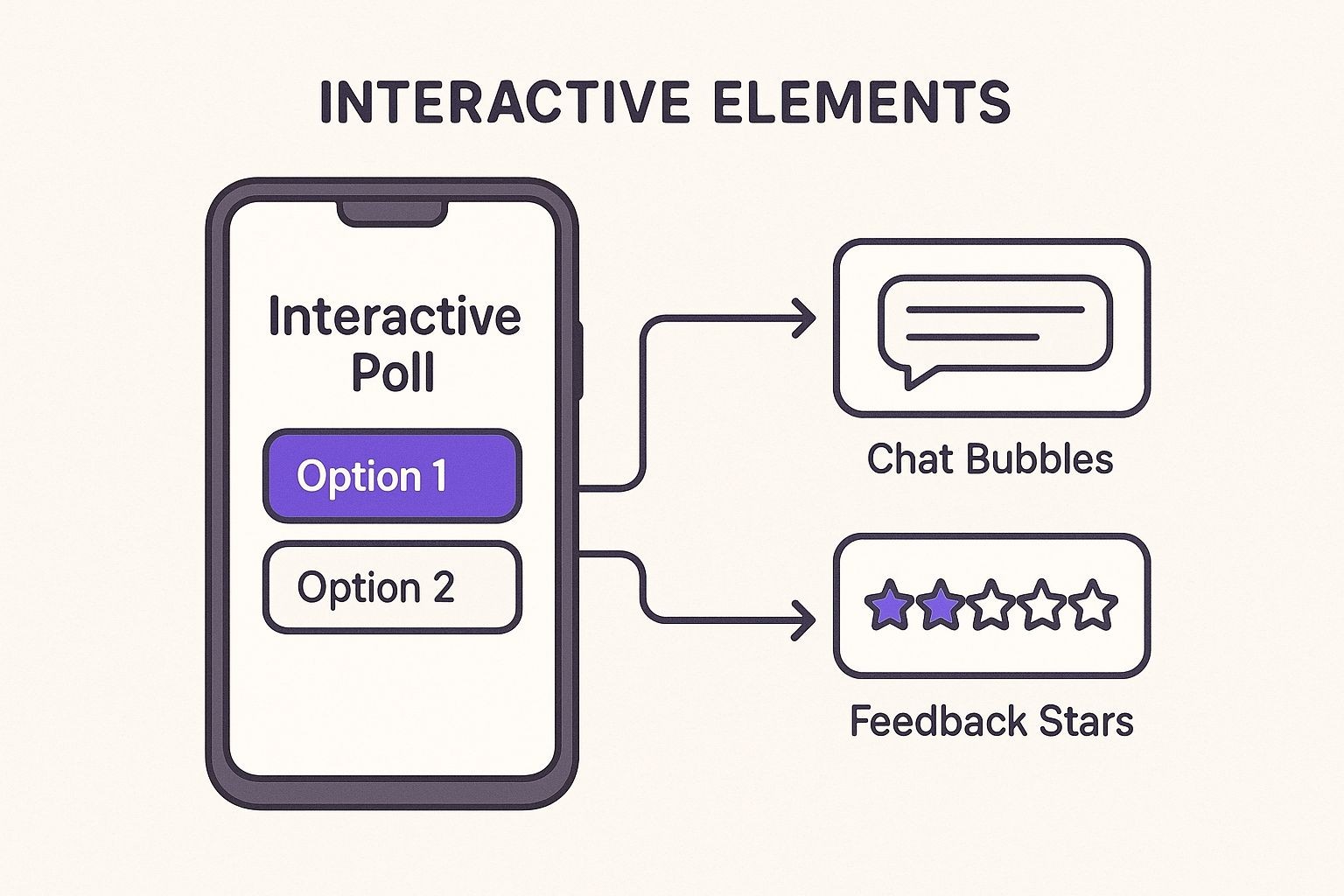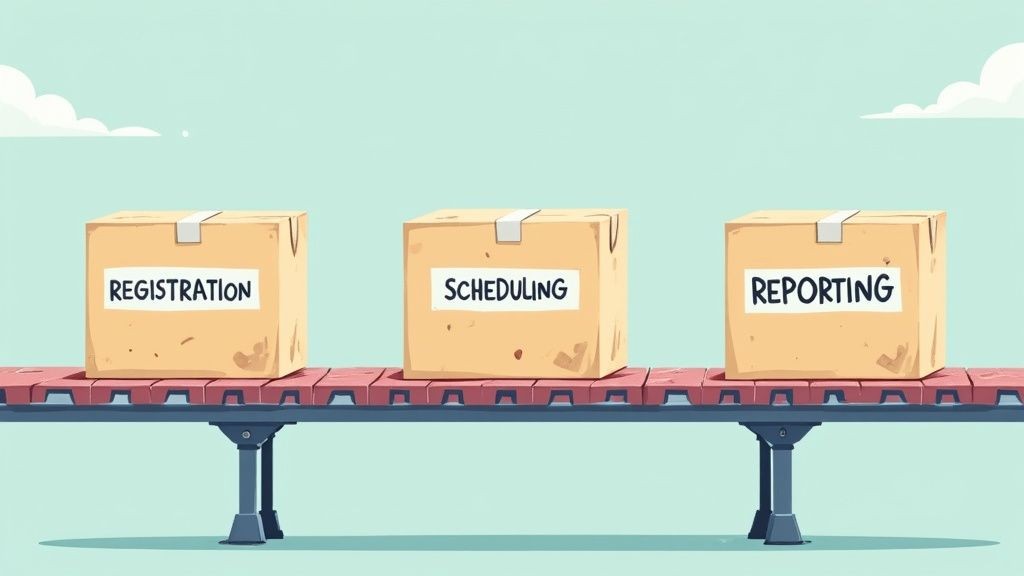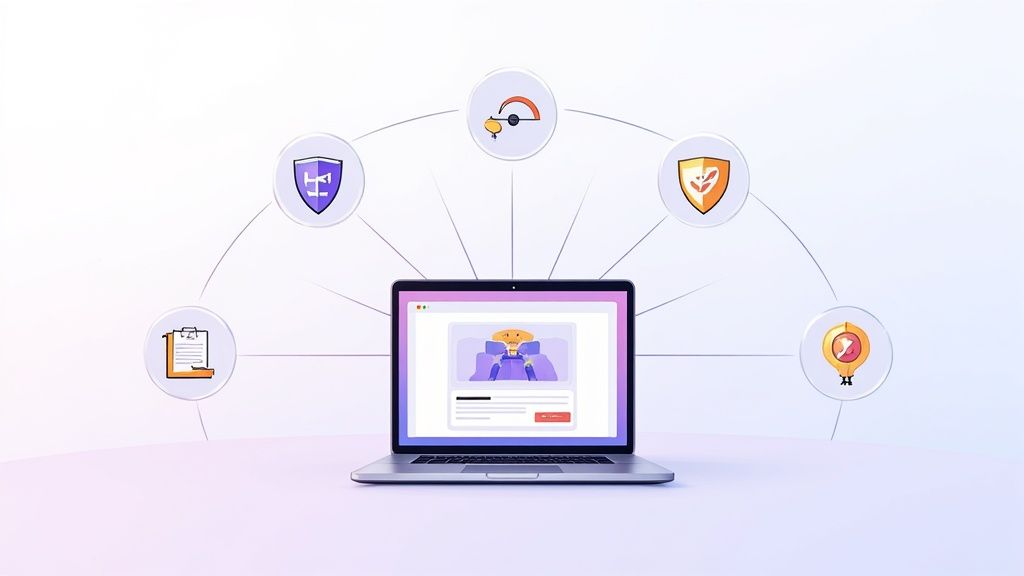Ever tried to plan a big corporate event using a tangled mess of spreadsheets, email chains, and a handful of different apps? It's a special kind of chaos, isn't it? Corporate event management software is designed to put an end to that madness.
Think of it as the central command center for your entire event, turning all those manual, error-prone tasks into a smooth, automated workflow.
The Digital Command Center for Your Events
Imagine trying to conduct an orchestra where every musician has a completely different sheet of music. That's what planning a corporate event feels like without a single, unified system. You’re bouncing between spreadsheets for the budget, a separate tool for registrations, endless email threads with vendors, and yet another platform for marketing. It’s exhausting.
Corporate event management software steps in as the conductor. It ensures every single piece of your event - from the first brainstorming session to the post-event analytics - is working in perfect harmony. It’s one ecosystem built to handle the entire lifecycle of your conferences, trade shows, product launches, or internal meetings.
From Disjointed Tasks to a Unified Strategy
At its heart, this software pulls all the critical event functions into a single dashboard. Instead of patching together different solutions and hoping they work, you get one cohesive system that manages it all. This move from fragmented processes to a unified strategy is a total game-changer.
This consolidation solves the biggest headaches for event planners by connecting and automating the most important activities:
- Planning and Logistics: Centralize everything from venue scouting and budget tracking to speaker management.
- Marketing and Promotion: Build event websites, run email campaigns, and see how your promotions are doing, all from one spot.
- Registration and Ticketing: Effortlessly handle attendee sign-ups, process payments, and manage ticketing.
- Attendee Engagement: Get people interacting during the event with tools like mobile apps, live polls, and dedicated networking features.
- Data and Analytics: Collect real-time data on who's registering, attending, and engaging to actually measure your event's ROI.
The global event management software market has seen some serious growth, which tells you just how much companies are relying on these tools. The market was recently valued at around USD 6.63 billion, a number that highlights just how many businesses are adopting these platforms, especially for large-scale corporate conferences. You can get more details by checking out the latest event management software market insights for a full forecast.
Why It’s More Than Just a Planning Tool
Ultimately, this kind of software is about making the entire event experience better for everyone. For planners, it means less time spent on tedious admin and more time to focus on creating an event that people will remember. For attendees, it means a seamless journey from the moment they register to the post-event follow-up.
By automating the repetitive stuff and serving up clear, actionable insights, this software gives teams the power to not only run events more efficiently but also to prove their strategic value back to the business. It turns events from a logistical headache into a measurable business driver.
This technology helps you move beyond just running an event. It lets you design, manage, and measure it with precision. You can finally ensure every conference or meeting hits its specific goals, whether that's generating leads, training employees, or building die-hard brand loyalty. The right platform doesn't just save you time and money; it amplifies the impact of every single event you host.
Core Features That Power Your Events
Let's get past the basic checklist. What really defines a great corporate event management software are the features that solve the real-world headaches event planners face every day. These tools are the engines that run everything from the first promotional email to the final post-event report, turning a mountain of tasks into a smooth, manageable process.
Think of these features not as separate items, but as interconnected gears in a machine. Each one has a specific job, but they all work together to create a flawless event.
Nail the First Impression: Registration and Ticketing
Your registration process is the first digital handshake you have with an attendee. It has to be a good one. Modern platforms go way beyond a simple sign-up form.
A powerful registration system automates the entire flow. You can build custom, branded registration pages that look and feel like your company, offer different ticket tiers (like early bird or VIP), and handle payments securely. Gone are the days of manually tracking who paid in a spreadsheet and cross-referencing it with a registration list. The software just does it.
This automation carries over to communication, too. As soon as someone signs up, the system can fire off a confirmation email, a receipt, and even a calendar invitation. This is a crucial little step that makes a huge difference in whether they actually show up. This is a place where our service often plugs in, providing rock-solid "add to calendar" buttons to help lock in that attendance from the get-go.
Essential Features of Event Management Software
To put it all in perspective, here’s a quick breakdown of the core features you'll find and the specific problems they're designed to solve.
| Feature | Primary Function | Key Benefit |
|---|---|---|
| Registration & Ticketing | Create custom forms, manage ticket types, and process payments. | Automates attendee sign-up and revenue collection, saving massive amounts of admin time. |
| Agenda Management | Build and display event schedules, speaker bios, and session details. | Gives attendees a clear, interactive roadmap of the event and helps them plan their day. |
| Attendee Engagement | Provide tools like live polls, Q&A, and in-app chat. | Transforms passive viewing into active participation, dramatically boosting satisfaction. |
| Mobile Event App | A centralized mobile hub for agendas, networking, and real-time notifications. | Puts the entire event experience in the attendee's pocket, increasing convenience and access. |
| Marketing & Promotion | Send branded email campaigns and create promotional landing pages. | Drives event awareness and registration by reaching the right audience with the right message. |
| Reporting & Analytics | Track registration numbers, attendee engagement, and post-event feedback. | Delivers concrete data to measure event success and prove ROI to stakeholders. |
| Integrations | Connect with other business systems like CRM and marketing automation tools. | Creates a single source of truth for attendee data and syncs event activity with other teams. |
These features are the building blocks of a strategic event program, moving you from just "running events" to driving real business outcomes.
Crafting the Perfect Event Agenda
Once people have registered, they need to know what’s happening and when. Agenda management tools are the heart of any good event platform. They let planners build out detailed schedules, showcase speakers with their bios and photos, and provide descriptions for every single session.
But it’s not just a static list anymore. The best software offers interactive agendas where attendees can browse the options and build their own personalized schedules. For a big conference with multiple tracks running at once, this is a game-changer. It empowers your attendees and, as a bonus, gives you invaluable data on which sessions are most popular, helping you decide where to allocate bigger rooms or more resources.
Sparking Real Engagement and Interaction
Keeping a crowd engaged - whether they're in the room or on a screen - is one of the toughest parts of the job. This is where interactive tools truly shine.
A study found that 82% of event organizers measure success by how satisfied their attendees are. Engagement features are the most direct way to boost - and measure - that satisfaction. They turn passive listeners into active participants.
Modern platforms pack a suite of these tools right into a dedicated event app, making participation easy:
- Live Polls: You can launch a poll during a session to get a quick pulse check from the audience or test their knowledge. Seeing the results pop up on screen in real-time is a great way to get people talking.
- Q&A Sessions: Instead of a chaotic "raise your hand" free-for-all, attendees can submit questions through the app. Others can upvote the questions they also want answered, pushing the most popular ones to the top for the speaker.
- Live Chat and Networking: Features that let attendees connect, schedule 1-on-1 meetings, and join group chats are key to building a sense of community. This is how you help people make the connections they came for.
The image below gives you a sense of how these tools come together on a phone, creating an interactive hub for every attendee.

As you can see, modern event apps centralize all this interaction, making it incredibly simple for people to get involved right from their devices.
The Power of Playing Well with Others: Integrations
Finally, no software is an island. A modern event platform absolutely must connect with your other business systems, like your Customer Relationship Management (CRM) or marketing software. This is non-negotiable.
Integrations are what give you a complete picture of your event's impact. For instance, connecting your event platform to Salesforce means that when a hot sales lead registers for your conference, that activity is automatically logged in their CRM profile. Your sales team gets crucial context, and you get to prove your event is helping fill the sales pipeline.
These connections are what elevate event management from a purely logistical role to a genuinely strategic one.
The Strategic Business Benefits of Event Software

It's easy to get lost in a long list of features, but the real magic of corporate event software isn't just about what it does. It's about the tangible business results it delivers. Think of it less as a planning tool and more as a strategic investment that directly impacts your bottom line, brand perception, and overall efficiency.
This kind of software transforms your events from simple logistical headaches into powerful engines for business growth.
By pulling all your event information - from registration data to attendee feedback - into one place, you finally get a 360-degree view of what's working. Instead of relying on guesswork, you can measure success against hard numbers. It lets you answer the big questions with actual data, proving the ROI for every single conference, webinar, or trade show you run.
Driving Operational Efficiency and Scalability
One of the first things you'll notice is a huge boost in your team's efficiency. Repetitive tasks like sending confirmation emails, processing payments, and generating attendee lists can be almost entirely automated. That's a ton of time saved.
This newfound bandwidth lets your team focus on the things that actually matter, like curating amazing content and creating unforgettable experiences for attendees.
This efficiency also means you can scale up your event program without scaling up your team at the same rate. The right software gives a small team the power to run bigger, more complex events without the proportional increase in stress and chaos. You can grow your event portfolio without having to exponentially grow your headcount.
Of course, this adaptability is key in today's work environment. Understanding the evolving landscape of office vs. work from home highlights just how crucial this technology is for supporting collaboration, no matter where your team or attendees are.
Enhancing Data Quality and Attendee Insights
Let's be honest: scattered data is unreliable data. When you're juggling multiple spreadsheets and disconnected tools, you completely lose sight of the bigger picture. A unified platform acts as your single source of truth, making sure the information you collect is clean, consistent, and ready to use.
This high-quality data gives you incredible insights into what your attendees are actually doing.
- Track Session Popularity: Finally figure out which topics and speakers truly connect with your audience.
- Monitor Engagement Levels: See who's actually participating in polls, Q&A sessions, and networking opportunities.
- Analyze Registration Trends: Understand precisely when people are signing up and which of your marketing channels are driving them there.
These aren't just vanity metrics; they're invaluable for shaping future event strategies and proving the value of your work to stakeholders.
The demand for this kind of data-driven event experience is exploding. Market forecasts show the industry rocketing from USD 17 billion to an incredible USD 82.3 billion by 2030. This growth is all about the need for frictionless events that deliver maximum ROI through automation and real-time analytics.
Boosting Attendee Satisfaction and Brand Consistency
A smooth experience is a satisfying one. Period. From a simple, intuitive registration page to a polished mobile app, event software ensures every touchpoint with your attendee is professional and hassle-free.
This polished experience is a massive driver of attendee satisfaction, which happens to be the #1 success metric for 82% of organizers.
On top of that, good software helps you maintain iron-clad brand consistency. Customizable templates for your websites, emails, and badges make sure every single communication perfectly matches your company's look and feel. This level of professionalism reinforces your brand's credibility and leaves a lasting positive impression on everyone who participates.
Want to take it even further? Check out our guide on 8 corporate event planning tips to refine your approach.
How to Choose the Right Software for Your Company
Picking the right corporate event management software can feel like staring at a wall of options. With dozens of platforms out there, all claiming to be the magic bullet, it’s easy to get analysis paralysis. The trick is to stop thinking of it as a simple purchase and start seeing it as a strategic investment in your event program's future.
Think of it like buying a new car. You wouldn't just pick one based on the paint job, right? You’d dig into the engine size, seating, fuel economy, and safety ratings. In the same way, the "best" software for you depends entirely on what you need, the kinds of events you run, and the people who will actually be using it.
Define Your Core Requirements First
Before you even glance at a single vendor’s website, you need to look inward. Seriously. Start by figuring out what a "win" looks like for your events and what headaches are currently getting in the way. Having a crystal-clear picture of your needs will be your North Star through this whole process.
Just make a simple list of "must-haves" versus "nice-to-haves." This first step is a game-changer for weeding out the wrong fits right from the start.
Ask yourself these foundational questions:
- What kind of events do you host? The tech needed for a massive international hybrid conference is worlds apart from what you need for a string of internal training webinars.
- What are your biggest pain points right now? Are you drowning in manual registration spreadsheets? Struggling to show any real ROI? Feeling like attendee engagement is a myth?
- Who will be using the software? A platform has to be intuitive for your entire crew - from the event coordinator to the marketing manager - not just the one tech wizard on the team.
Key Criteria for Comparing Software
Once your requirements are locked in, you can start stacking platforms up against a consistent set of criteria. This forces you to make an apples-to-apples comparison instead of getting distracted by flashy features that don't actually solve your problems. Focus on what will directly boost your team's efficiency and your attendees' experience.
The right software should feel like a natural extension of your team, making your job easier, not adding another layer of complexity. User-friendliness is non-negotiable because a tool that no one wants to use is a wasted investment.
Here's a breakdown of what to keep an eye on:
- Ease of Use: How intuitive is this thing? A platform should be a breeze to navigate for both your internal team and your attendees. Always ask for a trial or sandbox environment so you can click around yourself.
- Integration Capabilities: Does it play nice with the tools you already use? You need it to connect smoothly with your CRM (like Salesforce) or marketing automation platform (like HubSpot). This is non-negotiable for keeping all your data in one place.
- Customer Support: What happens when you hit a wall? Look for vendors with a reputation for responsive, helpful support teams. Check out reviews on sites like G2 or Capterra to see what actual users are saying.
- Security Protocols: How is your data - and more importantly, your attendees' data - being protected? Make sure the vendor is compliant with privacy laws like GDPR and has solid security measures in place.
The Product Demo Is Your Best Friend
Never, ever commit to a platform without seeing it in action. A product demo is your chance to put the software through its paces and ask the tough questions that reveal its true colors. Don't just sit back and watch a canned sales pitch; show up with a list of your own real-world scenarios.
Ask the salesperson to show you exactly how you would do specific tasks. For instance, have them walk you through setting up a multi-track agenda or demonstrate how the system sends out personalized communications. For a deeper look into that, our guide on crafting the perfect event email reminder offers some great context for what you might need.
A Simple Checklist for Your Evaluation
To keep all your findings straight, a simple checklist or scorecard is your best friend. This is all about staying objective and making a decision based on data, not just a gut feeling.
Here's a handy checklist you can adapt to organize your thoughts and compare vendors head-to-head.
Software Evaluation Checklist
| Evaluation Criteria | Questions to Ask | Importance (High/Medium/Low) |
|---|---|---|
| Core Functionality | Does it have all of our "must-have" features? | High |
| Ease of Use | Can our least tech-savvy team member learn this quickly? | High |
| Integrations | Does it connect with our CRM, marketing, and other key tools? | High |
| Attendee Experience | Is the registration and event interface smooth for attendees? | High |
| Customer Support | What are their support hours? Do they offer phone/chat/email? | Medium |
| Security & Compliance | Is it GDPR/CCPA compliant? What are its security certs? | High |
| Reporting & Analytics | Can we easily track the metrics that matter to our stakeholders? | Medium |
| Scalability | Can the platform grow with us as our events get bigger? | Medium |
| Pricing & Value | Is the pricing transparent? Does it fit our budget long-term? | High |
Using a structured approach like this ensures every stakeholder gets a say and that the tool you choose truly fits your long-term strategy, budget, and team's skills.
Integrating Event Tech Into Your Daily Workflow
Picking the right corporate event management software is a huge step, but honestly, it’s just the start. The real magic happens when the technology weaves itself into your team's daily grind, becoming so natural you forget how you ever managed without it. That's what separates a pricey subscription from a strategic tool that genuinely changes how you run events.
Think of it like getting a new, high-tech kitchen. You've got all the best gadgets, but they're just shiny boxes until you learn the recipes and get into a rhythm. Your event software is the same - it needs a smart, deliberate rollout to really shine.
Start with a Phased Rollout
Going all-in from day one is a recipe for overwhelm. Instead of unleashing every single feature for every event at once, take it slow with a phased approach. This keeps things from getting chaotic and lets your team build up their confidence one step at a time.
For example, why not test the waters with a smaller, internal event first? Focus on getting just one or two core things right, like registration and basic email comms. This gives everyone a low-stakes sandbox to play in, letting them get comfortable with the interface before you use it for that massive, client-facing conference.
Adopting new tech is as much about people as it is about the platform. A gradual rollout respects the learning curve and can turn potential grumbling into genuine enthusiasm by proving the software’s worth in small, manageable wins.
This method also lets you collect feedback, identify your internal power-users who can help others, and smooth out any wrinkles in the process. Once the team has nailed the basics, you can start layering in the more advanced stuff, like the mobile app or deep-dive analytics, in future events.
Training and Creating Standard Processes
Good training isn't optional; it's the bedrock of a smooth rollout. Your mission is to make every team member feel like they can use the software with their eyes closed. A single kickoff meeting won't cut it - you need ongoing resources.
- Role-Specific Training: Not everyone needs to be a master of everything. Your marketing lead should become an expert on the promo tools, while your on-site coordinator needs to know the check-in app inside and out. Tailor the training to what people actually do.
- Create Standardized Templates: This is a massive time-saver. Build out templates for the events you run over and over. A pre-built template for your quarterly webinar series - complete with branding and automated reminder emails - ensures consistency and lets you spin up a new event in minutes, not hours.
By setting up these standard ways of working, you make the software the path of least resistance. It just becomes easier to follow the new, efficient process than to slide back into old, clunky habits.
Connecting Your Entire Event Ecosystem
Your event management platform is the powerful heart of your tech stack, but it can't be a lone wolf. To get a complete picture of your event's impact, you have to connect it to other critical business systems like Salesforce or HubSpot. This is how you turn event activity into business intelligence you can actually use.
But the ecosystem doesn't end there. Once your main platform handles the big jobs like registration, you have to nail the final, crucial mile of the attendee journey. You need to make sure those sign-ups actually show up.
This is where specialized tools come in. For instance, after someone registers, the very next step is getting that event onto their personal calendar. Our service, slots in perfectly right here. By dropping a simple "add to calendar" button in your confirmation emails and on your thank you pages, you give attendees a one-click way to block out the time. It’s a tiny action that has a huge impact on attendance rates, acting as an automatic reminder right where they manage their day.
You can learn more about perfecting this part of the process in our guide to creating an effective event landing page. Think of it as the final handshake that keeps your event top-of-mind long after they've hit "register."
What’s Next for Corporate Event Technology?
The world of corporate events doesn't stand still, and neither does the technology that makes it all happen. If you want to future-proof your event strategy, you need to look beyond today’s tools and see where the industry is headed. The next wave of event management software is shaping up to be smarter, more immersive, and a whole lot more conscious of its impact.
Software continues to be the dominant force in the event tech market, and for good reason. Its flexibility was a lifesaver for managing the virtual and hybrid events that have become the new normal. Now, things are about to get even more interesting. We’re seeing innovations like AI-powered chatbots and machine learning that will completely change the game by personalizing attendee interactions and delivering seriously sharp analytics. For a deeper dive, check out the full event management software market analysis.
We're moving past simple automation and into an era of truly intelligent event planning.
AI Is Becoming the Event Planner's Co-Pilot
Artificial Intelligence (AI) is quickly turning into the invisible assistant every event planner wishes they had. Its real magic lies in creating a unique, personalized experience for every single person who shows up, finally moving us away from the one-size-fits-all model.
Imagine an event app that does more than just show you a schedule. AI-driven platforms can look at an attendee's job title, their stated interests, and even which sessions they’ve attended before to suggest a custom-built itinerary. That means pointing them to the most relevant talks and - more importantly - connecting them with other people who share their goals.
It’s not just about making things easier; it’s about creating real value. When AI can recommend the right connections, it helps facilitate the exact kind of networking people show up for in the first place.
This intelligence isn't just for attendees, either. Predictive analytics can help you forecast how many people will be in a specific breakout session, letting you optimize room layouts and even get catering numbers right to cut down on waste. It’s about using data to actively shape a better event as it happens, not just report on it afterward.
AR and VR Are Making Events More Immersive
Augmented Reality (AR) and Virtual Reality (VR) are still finding their footing in the corporate world, but they're poised to completely redefine what we mean by "engagement." The virtual and hybrid platforms we use today are evolving to feel less like a long video call and more like a real gathering.
Think about what this could look like:
- Virtual Venue Tours: Let remote attendees walk through a digital version of the event space, pop into sponsor booths, and interact with 3D product models.
- Augmented Reality Overlays: An in-person attendee could point their phone at the stage to see a speaker's bio pop up or view an interactive product demo right on the showroom floor.
- VR Breakout Rooms: Small groups could meet up in a shared virtual space for a brainstorming session that feels way more natural and collaborative than a typical video chat.
The Big Push for Sustainability
Let's be honest: sustainability is no longer a "nice-to-have." It’s a core business requirement, and modern event software is stepping up to help planners measure and reduce their event's environmental footprint.
We’re seeing new features that let you track key sustainability metrics right from your dashboard. This covers everything from calculating the carbon footprint of your attendees' travel to monitoring food waste and energy use at the venue. By putting this data at your fingertips, the software gives you the power to make smarter, eco-friendly decisions and confidently report on your sustainability wins.
At Add to Calendar PRO, we believe the best technology is the kind that cuts through the noise and gets you real results. While you’re managing the big picture with your event platform, our service makes sure your attendees never miss a thing. By making it dead simple for them to add your event to their calendar, you drive up attendance and keep your event on their radar. Learn more at https://add-to-calendar-pro.com.



